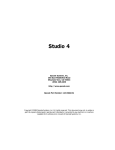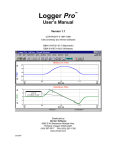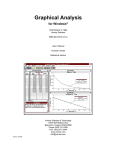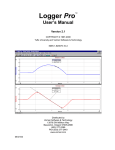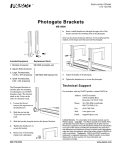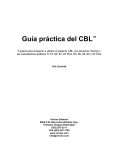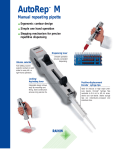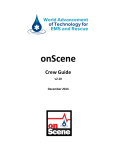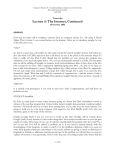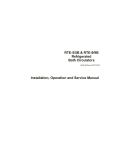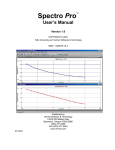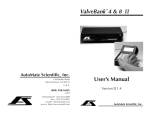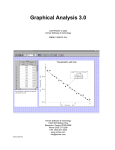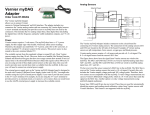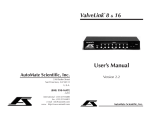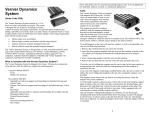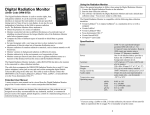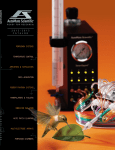Download Manual - Vernier Software & Technology
Transcript
Universal Lab Interface User’s Manual Vernier Software & Technology 13979 S.W. Millikan Way Beaverton, OR 97005-2886 (503) 277-2299 • FAX (503) 277-2440 [email protected] • www.vernier.com Version 5/00 ULI User’s Manual Table of Contents About the ULI Manuals ......................................................................3 Introduction ........................................................................................5 Getting Started ............................................................................7 Parts List ..............................................................................7 Initial Setup on a Macintosh..................................................7 Initial Setup on IBM Compatibles ..........................................8 Software for Use with the ULI ......................................................9 ULI Software for Macintosh...................................................9 ULI Software for Windows ..................................................13 ULI Software for MS-DOS...................................................14 Sensors for Use with the ULI .....................................................19 Curriculum Material for Use with the ULI ...................................25 ULI Connectors .........................................................................27 Appendix A Appendix B Appendix C Appendix D – About the Universal Lab Interface ............................29 – Troubleshooting Guide.............................................30 – Technical Information on the ULI Hardware .............31 – Other Vernier Software Products .............................32 Page 2 ULI User's Manual About the ULI Manuals About this Manual The ULI User’s Manual presents an overview of the Universal Lab Interface. It assumes that you will be using either a Macintosh or an IBM-compatible computer and software written specifically for use with the ULI. The first section explains how to set up the ULI and the computer. The next sections describe the software, sensors, and curricular materials that are available for use with the ULI. The appendixes include information on how the ULI was developed, troubleshooting tips, hardware specifications for the ULI, and information on other Vernier Software products. This manual is written for use with the ULIII, first sold by Vernier Software in 1995. The term “ULI” in this manual refers specifically to the ULIII. Other ULI Manuals Software Manuals: There are Macintosh programs, MS-DOS programs, and a Logger Pro for Windows program, all designed specifically for use with the ULI. Each of these programs comes with a manual that describes how to use the program with the appropriate probes and sensors. ULI Software Developer’s Guide: The ULI Software Developer's Guide explains how you can control the ULI using virtually any computer. The ULI contains more than 15 machine-coded routines built into its EPROM. These routines handle the preprocessing of signals from sensors and the serial communication with the host computer. There are two ways that you may want to use these built-in routines: (1) If you are a programmer, you can incorporate them into your programs written for almost any computer. Your software can then control and read a wide range of sensors and probes. (2) You can simply use a telecommunications program to “manually” control the ULI. Data can be collected by typing just a few characters. Some instructors use this method of data acquisition to bring data directly into spreadsheets on both Macintosh and IBM compatible computers. The Macintosh ULI Software Developer’s Guide includes a ULI HyperCard Starter Stack. This product is to be used for educational purposes only. Vernier Software is not responsible for equipment use outside this intent. This equipment is not appropriate for industrial, medical, research or commercial applications. Macintosh® and HyperCard® are registered trademarks of Apple Computer, Inc. Windows, Windows 95, MS-DOS, ULI User's Manual Page 3 Microsoft Works, Microsoft Word, and Excel are registered trademarks of Microsoft, Inc. IBM and Proprinter are registered trademarks and IBM PC, IBM PC-XT, IBM PC-AT, IBM PS/2, BASICA, and PC-DOS are trademarks of International Business Machines Corporation. Page 4 ULI User's Manual ULI User's Manual Page 5 Universal Lab Interface User’s Manual Introduction In most modern experimental laboratories, electronic sensors are used to collect data automatically. It is possible to attach these sensors to computers—a very powerful capability. Microcomputers, with the appropriate software packages, are capable of analyzing the signals and instantly displaying them on the screen in easily understood forms. By coupling the collection of real data with a symbolic representation of it in the form of a graph, you can obtain an immediate “real time” picture of the data while it is being collected. The Universal Lab Interface (ULI) provides an ideal way of doing this kind of data collection and analysis. The ULI project started in the fall of 1986 at Dickinson College, Tufts University, and Technical Education Research Centers (TERC). The ULI was conceived as a way to allow sensors to be connected to any computer with a serial port. A series of sensors have been developed for use with the ULI. The ULI was designed and is manufactured by Transpacific Computer Company. The ULIII was introduced in 1995. The ULI software and probes were originate primarily at two institutions of higher education, Tufts University and Dickinson College. Since its introduction, programs have been developed at the Center for Science and Mathematics Teaching at Tufts University and at Vernier Software. Sensors have been developed at Vernier Software, Tufts University, and Dickinson College. Curricular materials have been developed by Tufts University, Dickinson College, and the University of Oregon. Refer to Appendix A for more information about the development of the ULI. This product is to be used for educational purposes only. Vernier Software is not responsible for equipment use outside this intent. This equipment is not appropriate for industrial, medical, research or commercial applications. Page 6 ULI User’s Manual ULI User’s Manual Page 7 Getting Started Parts List The Universal Lab Interface (ULI) package should contain all of the following. If any of these items are missing from your package, please contact Vernier Software. • Universal Lab Interface • ULI User's Manual (this manual) • 9-V, 1-amp power supply • One Voltage Probe If you purchased the ULI for use with a Macintosh: • Cable to Macintosh (with mini-DIN plug) If you purchased the ULI for use with an IBM-compatible computer: • Cable to the IBM serial port (including 9-pin to 25-pin adapter) Initial Setup on a Macintosh The ULI should be placed on the desktop near the Macintosh. Use the modem cable to connect the Serial I/O port on the back of the ULI to the modem port at the back of the Macintosh.1 to modem port Universal Lab Interface to Serial I/O to 9V/1A to 115 VAC ULI Connections Next, plug the 9-volt power supply into the receptacle on the back of the ULI and plug it into a source of 60-hertz, 115-VAC power. Now you need to connect the appropriate detectors to the ULI. Many of them are described in the “Probes and Sensors” section of this manual. Refer to this section if you are uncertain how to connect the device you want to use. Turn on the ULI using the toggle switch on its back side. The green LED on the left-front side of the ULI will light when the power is on. 1The ULI can also be connected to the printer port of the Macintosh. Page 8 ULI User’s Manual At this point, you can start the ULI program as you would any other Macintosh program. Refer to the manual that came with the program for software information. These manuals explain how to use the program, the ULI and the sensors to do experiments. Note: Data Logger, MacMotion, MacTemp, and Sound must be version 4.5 or newer to be used with the ULIII. If you have any difficulty starting up the program, consult Appendix B of this manual—the Troubleshooting Guide. Initial Setup on IBM-Compatibles To use the ULI with an IBM-compatible computer, the computer must have a free serial port. The ULI should be placed on the desktop near the computer. Use the serial port cable to connect the Serial I/O port on the back of the ULI to the serial port at the back of the computer. If your computer’s mouse is connected to a serial port (COM1), you will need to connect the ULI cable to a second serial port (COM2). If necessary, refer to your computer or accessory card manuals to determine which serial ports are available. to modem port Universal Lab Interface to Serial I/O to 9V/1A to 115 VAC ULI Connections Depending on the type of computer you are using, you may have serial ports with either 25-pin sockets or 9-pin sockets. The cable supplied by Vernier Software for use with the ULI will work with either type of serial port. If you are using a 9-pin serial port, just use the socket on one end of the cable. If you are using a 25-pin serial port, plug the short adapter into the 9-pin socket end of the cable to provide the necessary 25-pin socket. Next, plug the 9-volt power supply into the receptacle on the back of the ULI and plug it into a source of 60-hertz, 115-VAC power. Turn on the ULI using the toggle switch on its back side. The green LED on the left-front side of the ULI will light when the power is on. At this point, you can start the ULI program as you would any other program. Refer to the manual which came with the ULI User’s Manual Page 9 program for software information. These manuals explain how to use the program, the ULI and the appropriate sensors to do experiments. If you use the MS-DOS Data Logger, Motion, Temperature, or and Sound programs, you must use version 4.5 or newer if you have a ULIII. The manuals for these programs explain how to use them with the appropriate probes to do experiments. If you have any difficulty starting up the program, consult Appendix B of this manual—the Troubleshooting Guide. Page 10 ULI User’s Manual Software for Use with the ULI We have software for using your ULI on Macintosh, Windows, or MS-DOS computers. If you use our ULI Software Developer’s Guide, you can develop ULI software for any computer with a serial port. ULI SOFTWARE FOR MACINTOSH Logger Pro for Power Macintosh Computers This software has all of the features you would expect in a Power Macintosh program—multiple windows, toolbar, copy and paste, lots of color, and an easy-to-use graphical interface. This comprehensive program may be used with our Motion Detector, photogates, Rotary Motion Sensor, and Radiation Monitors, as well as with our analog sensors for studying force, sound, acceleration, temperature, pressure, EKG, light, magnetic field, pH, conductivity, CO2, and dissolved oxygen. Logger Pro provides all of these features: • extensive analysis tools, including tangent line, integration, statistics, curve fitting, calculated columns, examine, and interpolation • multiple data runs • monitor up to four inputs • data display in several windows using graphs, data tables, meters, etc. • easy sensor and experiment setup with pre-saved experiment files • annotation of graphs and notes in a text window Developed by Tufts University and Vernier Software. System requirements: Power Macintosh, System 7.6 or OS8, 16M of RAM, an unused modem or printer port. Order code LP-MAC, $59. Macintosh ULI Data Collection Software Package (for Older Macintosh Computers) This package for older Macintosh computers includes four programs: Data Logger, Motion, Sound, and ULI Timer. This software is used with a motion detector, photogates, or with any of our analog sensors for studying force, acceleration, sound, temperature, pressure, EKGs, light, magnetic fields, pH, conductivity, CO2, and dissolved oxygen. Order code USPDOS, $49.00. More about the programs in the Macintosh ULI Data Collection Package: ULI User’s Manual Page 11 Data Logger: The Data Logger program was developed at the Center for Science and Mathematics Teaching at Tufts University in Medford, Massachusetts. It collects data from the voltage input lines of the ULI. It can be calibrated to display other measurements, such as pH, temperature or force. Any probe/sensor which produces an output voltage in the range 0 - 5 volts DC can be used with this program. The Voltage Measurement Leads included in the ULI package allow the ULI and Data Logger to be used as a “graphing voltmeter.” The sample graph below shows a capacitor charging and discharging. A Capacitor Charging and Discharging Graph Sound: Sound provides an excellent way of analyzing sound waves. You can capture several sound wave patterns on the screen and compare them. Fourier Analysis of a sound can also be done. The Sound program requires a ULI Microphone (available from Vernier Software). Sound Sample Graph ULI Timer: ULI Timer was developed for use with the ULI by Vernier Software. It requires a photogate system connected to the Digital Input RCA phono connectors. Vernier photogates, PASCO photogates, PASCO smart pulleys, or photogates made from a Vernier Software parts kit can be used. The program can Page 12 ULI User’s Manual be used to study free fall, pendula, rolling carts or air track gliders. A Sample ULI Timer Graph MacMotion: MacMotion software for use with the ULI has been designed by Ronald Thornton and Stephen Beardslee at the Center for Science and Mathematics Teaching at Tufts University in Boston. It requires a Motion Detector. A Force Probe can also be used. MacMotion Graphs Additional Macintosh Programs The ULI Macintosh Data Collection Package will handle most data collection and analysis. Additional software is available for use with our radiation monitors, Rotary Motion Sensor, and Current and Voltage Probe System. Our HyperCard Starter Stack is for people who want to quickly develop their own programs to monitor sensors using the ULI. These additional programs are not needed if you are using Logger Pro. Event Counter: Event Counter is used to count nuclear radiation. It requires the Radiation Monitor. Order code M-EC, $30. ULI User’s Manual Page 13 Electricity: The Electricity program and Current and Voltage Probes allow you to do a wide variety of experiments with electric circuits. The program can automatically detect whether current or voltage probes are connected. Order code M-EL, $30. Rotary Motion: Monitors and graphs the angular or linear motion of the Rotary Motion Sensor. The software measures to the nearest 0.25 degree and senses direction. An analog sensor (light level, magnetic field, force, etc.) can be monitored at the same time. Order code M-RT, $30. MacTemp: MacTemp was designed by Ronald Thornton and Stephen Beardslee at Tufts University. It requires temperature probes (two probes may be used at once). MacTemp also supports the use of a Heat Pulser to add known amounts of heat energy to a system. This program is necessary only if using the Heat Pulser. Order code M-TP, $30. Page 14 ULI User’s Manual MacTemp Sample Graph ULI HyperCard Starter Stack: This simple stack controls the serial port and lets you work with the ULI from the HyperCard environment. It simply displays raw data and does very simple graphs. You or your students can modify the stack in various ways. This stack is a good place to start if you want to write your own programs to take data with the ULI. The ULI HyperCard Starter Stack is included with the ULI Software Developer’s Guide. $15 ULI SOFTWARE FOR WINDOWS Logger Pro for Windows This software has all of the features you would expect in a Windows program—multiple windows, toolbar, copy and paste, lots of color, and an easy-to-use graphical interface. This comprehensive program may be used with our Motion Detector, photogates, Rotary Motion Sensor, and Radiation Monitors, as well as with our analog sensors for studying force, sound, acceleration, temperature, pressure, EKG, light, magnetic field, pH, conductivity, CO2, and dissolved oxygen. Logger Pro provides all of these features: ULI User’s Manual Page 15 • extensive analysis tools, including tangent line, integration, statistics, curve fitting, calculated columns, examine, and interpolation • multiple data runs • monitor up to four inputs • data display in several windows using graphs, data tables, meters, etc. • easy sensor and experiment setup with pre-saved experiment files • annotation of graphs and notes in a text window Developed by Tufts University and Vernier Software. System Requirements: Windows 95, Windows NT, Windows 3.1, 486, 8M of RAM minimum, 16 MB of RAM recommended, an unused serial port. Order code LP-WIN, $59.00. ULI SOFTWARE FOR MS-DOS Data Collection Software Package This package includes three programs: Data Logger, Motion, and Sound. This software is used with a motion detector or any of our analog sensors for studying force, acceleration, sound, temperature, pressure, EKGs, light, magnetic fields, pH, conductivity, CO2, and dissolved oxygen. Order code USP-DOS $49. Data Logger, Motion, and Sound are also available individually for $30 each. System Requirements: MS-DOS 3.3 or newer, 386, 1M of RAM, mouse, and an unused serial port. More about the programs in the ULI MS-DOS Data Collection Package: Data Logger: Data Logger is included with the IBMcompatible ULI package. This program comes on a doublesided, non-copy protected 800K disk. A short manual accompanies Data Logger which gives details on how the program and the associated probes can be used. Four other programs are sold separately for use with the ULI and IBMcompatible computers: Temperature, Motion, Sound, and Event Counter. Note that all of these programs (except Event Counter) must be version 4.5 or newer to be used with the ULIII. The Data Logger program was developed at the Center for Science and Mathematics Teaching at Tufts University in Medford, Massachusetts. It collects data from the voltage input lines of the ULI. It can be calibrated to display other measurements, such as pH, temperature or force. Any Page 16 ULI User’s Manual probe/sensor which produces an output voltage in the range 0 - 5 volts DC can be used with this program. The Voltage Measurement Leads included in the ULI package allow the ULI and Data Logger to be used as a “graphing voltmeter.” A Capacitor Charging and Discharging Graph Motion: Motion software for use with the ULI has been designed by Ronald Thornton and Stephen Beardslee at the Center for Science and Mathematics Teaching at Tufts University in Boston. It requires a Motion Detector. A Force Probe can also be used. Order code PC-MO, $30. A Sample Motion Screen Sound: Sound provides an excellent way of analyzing sound waves. You can capture several sound wave patterns on the screen and compare them. Fourier Analysis of a sound can also be done. The Sound program requires a ULI Microphone. ULI User’s Manual Page 17 A Sample Sound Screen, Showing an FFT Additional MS-DOS Programs The ULI MS-DOS Data Collection Package will handle most data collection and analysis. Additional software is available for use with our radiation monitors, heat pulsers, Rotary Motion Sensors, and our Current and Voltage Probe System. These additional programs are not needed if you are using Logger Pro. Event Counter: Event Counter is used to count nuclear radiation. It requires the Radiation Monitor. Order code PC-EC, $30. Rotary Motion: This program is for use with our Rotary Motion Sensor. It monitors and graphs the angular or linear motion of the Rotary Motion Sensor. The software measures to the nearest 0.25 degree and senses direction. An analog sensor (light level, magnetic field, force, etc.) can be monitored at the same time. Order code PC-RT, $30.00. Electricity: The Electricity program and Current and Voltage Probes allow you to do a wide variety of experiments with electric circuits. The program can automatically detect whether current or voltage probes are connected. Order Code PC-EL, $30. Page 18 ULI User’s Manual Temperature: Temperature was designed by Ronald Thornton and Stephen Beardslee at Tufts University. It requires temperature probes. Temperature also supports the use of a Heat Pulser to add known amounts of heat energy to a system. Temperature is necessary only if you are using a Heat Pulser. Order code PC-TP, $30. A Sample Temperature Graph Photogate Timing If you are interested in doing photogate timing using the ULI, we have a simple timing program that collects and displays times. You can collect the data with this program, then take the data to a spreadsheet program for analysis and graphing. There is no charge for this program. Order PTM-DOS for the MS-DOS version. ULI User’s Manual Page 19 Sensors for Use with the ULI Many different sensors can be used with the ULI. These are available from Vernier Software. Sensor Price/Order Code Motion Detector $65 (MD-ULI) ULI Microphone $30 (MCA-ULI) Student Force Sensor $99 (SFS-DIN) ULI Force Probe $130 (FP-ULI) Dual-Range Force Sensor $98 (DFS-DIN) Magnetic Field Sensor $44 (MG-DIN) Light Sensor $39 (LS-DIN) Low-g Accelerometer $88 (LGA-DIN) 25-g Accelerometer $99 (ACC-DIN) 3-Axis Accelerometer $199 (3D-DIN) Current & Voltage Probe System $84 (CV-DIN) Vernier Photogate (Assembled) $39 (VPG-DG) Photogate Parts Kit2 $9 (PGK-DG) Rotary Motion Sensor $185 (RMS-ULI) Student Radiation Monitor $138 (SRM-DG) Radiation Monitor $199 (RM-DG) Instrumentation Amplifier $49 (INA-DIN) Pressure Sensor $69 (PS-DIN) Direct-Connect Temperature Probe $28 (DCT-DIN) Standard Temperature Probe $43 (TPA-DIN) Extra Long Temperature Probe $68 (TPL-DIN) pH System $72 (PH-DIN) Colorimeter $99 (COL-DIN) Conductivity Probe $79 (CON-DIN) Thermocouple $35 (TCA-DIN) Ion-Selective Electrodes (Require ISE-DIN) $149 (see next page) ISE Amplifier $39 Dissolved Oxygen Probe $189 (DO-DIN) Heart Rate Monitor $47 (HRM-DIN) Exercise Heart Rate Monitor $89 (EHM-DIN) EKG Sensor $175 (EKG-DIN) Biology Gas Pressure Sensor $68 (BGP-DIN) CO2 Gas Sensor $259 (CO2-DIN) Respiration Monitor Belt $58 (RMB) (Requires Biology Gas Pressure Sensor) Sensor 2For Price/Order Code a ULI purchased prior to 1995, order the 2-Photogate Parts Kit (2PUL, $38). Page 20 ULI User’s Manual Barometer $56 (BAR-DIN) Relative Humidity Sensor $65 (RH-DIN) Voltage Probe (One included with ULI) $7 (VP-DIN) Motion Detector A Motion Detector is similar to the automatic range finder on Polaroid cameras. It emits ultrasonic pulses and measures the length of time it takes for the reflected pulses to return. From this time and the known speed of sound, it calculates a distance. By using several successive distance measurements, the computer can also calculate velocity and acceleration. The Motion Detector attaches to the Port 2 modular phone connector. ULI Microphone The ULI Microphone plugs into the DIN 1 connector of the ULI and is used for studying sound waves. Force Probe A Force Probe determines how much force (either push or pull) is being applied to it and returns this measurement to the ULI and then the computer. This probe can be used with the motion detector to explore Newton's Second Law. The Force Probe contains a Hall effect sensor that responds electrically to changes in magnetic field. The moveable portion of the probe has a small permanent magnet attached to it. The force on the probe is determined indirectly by measuring the magnetic field at the Hall sensor. The Force Probe attaches to the Port 1 modular phone connector. Dual-Range Force Sensor This very low-noise, stable, strain-gage based, force sensor. It can be hand held, mounted on a ringstand, or mounted on a dynamics carts. It is great for collision experiments and Newton’s third law experiments. It has two ranges (±5 N and ±50 N). Student Force Sensor This sensor plugs into the ULI and reads either pushes or pulls in the range 0.05 to 20 newtons. It uses strain gages built into a U-shaped device that is meant to be either hand held or mounted on a ringstand. Magnetic Field Sensor This sensor, which uses a Hall Effect transducer, is sensitive enough to measure the earth’s magnetic field. It can also be used to study the field around permanent magnets, coils, and electrical devices. Its two ranges are ±3.2 x 10-4 tesla and ±6.4 x 10-3 tesla. Light Sensor Our Light Sensor approximates the human eye in spectral response and can be used over three different illumination ranges, which you select with a switch. Use it for inverse square law experiments or for studying solar energy. The ranges are 0600, 0-6000, 0-150,000 lux. ULI User’s Manual Page 21 Low-g Accelerometer This sensor measures acceleration in the range of ±50 m/s/s (±5 g). It has a flexible 2-meter cables. It is useful for studying motions with smaller accelerations, like cars (real and toy), elevators, and amusement park rides. 25-g Accelerometer This sensor measures acceleration in the range of -25 to + 25 g. It can be used to measure acceleration of objects or people. It works great for making centripetal force measurements or monitoring changes in acceleration during collisions. When used with a force sensor, the relationship between force and acceleration can be investigated. 3-Axis Accelerometer This sensor is equivalent to 3 of our Low-g Accelerometers mounted at right angles to each other. Each sensor has the range of ±50 m/s/s (±5 g). It has a flexible 2-meter cables with three DIN plugs on the end. Current & Voltage Probe System The Current & Voltage Probe System was designed to monitor currents and voltages in DC and AC circuits with the ULI. The system consists of an amplifier box, two current probes, and two voltage probes. Any combination of two probes can be used at once. The voltage range is ±6 volts (wider than with our Voltage Measurement Leads) and with differential units. The current range is ±0.6 amps. Photogates Photogates for timing can be connected to the DG 1 or DG 2 connectors on the ULI. They are used with Logger Pro, the ULI Timer software (Macintosh only), or with our MS-DOS timing module. One or two photogates may be used. The Vernier Photogate is an assembled, ready-to-use photogate. Vernier Software also sells a photogate parts kit, which includes all the parts needed to build one photogate. Rotary Motion Sensor Our Rotary Motion Sensor lets you monitor angular motion accurately and easily. It has a resolution of 0.25 degrees and can sense direction. You can use our it with our Logger Pro software or our Rotary Motion software to graph angular displacement, angular velocity and angular acceleration. Typical experiments include measuring moments of inertia, torque, transmission of light through a polarizing material as a function of angle, pendula, and Atwood’s machines. Even though we call it the Rotary Motion Sensor, it also can be used to measure linear position to a fraction of a millimeter by simply rolling the sensor along a table. The Rotary Motion Sensor was developed in collaboration with the Center for Science and Mathematics at Tufts University. Instrumentation The Instrumentation Amplifier monitors voltages from a few Page 22 ULI User’s Manual Amplifier millivolts (DC or AC). It has several switch settings to allow you to select the best gain. A typical use would be to amplify the chart recorder output of an instrument so that its signal can be used with the ULI. Radiation Monitors Vernier Software offers two different radiation sensors for use with the ULI. A radiation monitor attaches to the DG 1 connector on the ULI. They can be used with a ULI to explore radiation statistics, measure the rate of nuclear decay, and monitor radon daughters. The Student Radiation Monitor (SRMDG) consists of a Geiger tube and ratemeter mounted in a small plastic case. The Radiation Monitor (RM-DG) is similar, but it is battery powered and has an analog rate indicator. It can be used as a stand-alone pocket radiation meter. Pressure Sensor Our Pressure Sensor has a range of 0 to 100 psi (0 to 6.8 atm) absolute pressure. It is designed for gas law experiments in chemistry, physical science, and physics. A plastic syringe and tubing are included for use with Boyle’s law experiments. Temperature Probes Vernier Software sells three different types of temperature probes that can be used with the Serial Box Interface. 1) Direct-Connect Temperature Probe: This is our most popular temperature probe. It has a Teflon-coated brass tube with a temperature sensor at the end. It can be used in a wide variety of chemicals with a temperature range of -15 to 110°C (±0.2°C in normal use). 2) Standard Temperature Probe System: This system has a signal-conditioning box and a probe with the same Teflon coating as the Direct-Connect Temperature Probe. The system has a range of -50 to 150°C. The probe can be disconnected from the box and replaced with a different type of temperature probe. These probes are sold separately. They are electronically the same probe, with the same temperature range, but packaged differently. 3) Extra Long Temperature Probe: This is the same as our Standard Temperature Probe, but with a 30-meter (100 ft.) cable. This probe is designed for remote, outdoor temperature sensing or for measuring temperature at various depths in lakes and streams. pH System Our pH System includes a pH Electrode and pH Amplifier. The pH Electrode is a Ag-AgCl combination electrode with a range of 0 to 13 pH. The pH Amplifier contains the signalconditioning circuitry. The Electrode is also available separately: pH Electrode (7120B, $32.00). pH Buffer capsules are also available for $10 (order code PHB). ULI User’s Manual Page 23 Colorimeter This is a 3-color (red-635 nm, green-565 nm, blue-470 nm) colorimeter. It is great for Beer’s law experiments, determining the concentration of unknown solutions, or studying changes in concentration vs. time. Fifteen 3.5-mL cuvettes are included. A package of 100 replacement cuvettes is available for $10 (order code CUV). Conductivity Probe This probe is great for environmental testing for salinity, total dissolved solids (TDS), or conductivity in water samples. Biology teachers can use this probe to demonstrate diffusion of ions through membranes or to monitor changes in ion levels in aquatic systems. Chemistry students can use it to investigate the difference between ionic and molecular compounds, strong and weak acids, or ionic compounds that yield different ratios of ions. The Conductivity Probe can monitor concentration or conductivity at three different sensitivity settings covering 010,000 mg/L TDS (0-20,000 µS). Ion-Selective Electrodes and Amplifier We have a family of solid-state and PVC membrane ionselective electrodes: Nitrate (NO3-), Chloride (Cl-), Calcium (Ca2+), and Ammonium (NH4+) ($149 each). This set of equipment is used to monitor ions that are present in the environment. The Vernier ISEs are a combination-style, nonrefillable, gel-filled construction. The Nitrate, Calcium, and Ammonium PVC ISEs all have replaceable membrane modules ($54). The Chloride ISE has a solid-state membrane and therefore does not need a replacement module. Our ISE Amplifier (ISE-DIN, $39), which is necessary for use with the ISE Electrodes, can be used with any of the four ISEs. Thermocouple This probe uses type-K thermocouple wire to measure the difference in temperature between its two junctions. It can be used over the range -200 to 1400°C (±10°C). It is great for studying flame temperatures. Dissolved Oxygen Probe Use the Dissolved Oxygen Probe to determine the concentration of oxygen in aqueous solutions in the range of 0-15 mg/L (ppm). It has built-in temperature compensation and a fast response time. This probe is great for biology, chemistry, ecology, or integrated science courses. Included with the probe is an amplification box, zero-oxygen solution, two membrane caps, a 100% calibration bottle, and electrode filling solution. Replacement membrane caps are available (order code MEM, $11). Heart Rate Monitor Use this sensor to monitor human heart rate at the earlobe or fingertip. An ear-clip sensor measures the change in light intensity as blood flows through the blood vessels. With each heart beat, the changing light intensity is measured, and the heart rate is determined. Macintosh or IBM (MS-DOS) programs Page 24 ULI User’s Manual are available to display heart rate in beats/minute, a data table with statistics, and a graph of heart rate vs. time. Exercise Heart Rate Monitor The Exercise Heart Rate Monitor is ideal for determining the heart rate of moving or active individuals. With this sensor, a person's heart rate is monitored electrically using a belt around the chest. This belt produces a signal which is broadcast to a small receiver nearby. The receiver connects to the ULI. Software is available to display heart rate in beats/minute, a data table with statistics, and a graph of heart rate vs. time. EKG Sensor The EKG Sensor measures electrical signals produced by the heart. It uses three disposable electrode packages. An EKG graph is displayed, demonstrating to students the contraction and repolarization of the heart’s chambers. A package of 100 disposable electrodes is included with the sensor. Biology Gas Pressure Sensor Use the Biology Gas Pressure Sensor to monitor gas-pressure changes due to respiration or transpiration. It can also be used as a standard barometer for monitoring air pressure. It can even be used to investigate pressure-volume or pressure-temperature experiments in chemistry. This sensor has a pressure range of 0.75 to 1.5 atm. CO2 Gas Sensor The CO2 Gas Sensor measures gaseous carbon dioxide levels in the range of 0 to 5000 ppm. This probe is great for measuring changes in CO2 levels during plant photosynthesis and respiration. With this sensor, you can easily monitor changes in CO2 levels occurring in respiration of organisms as small as crickets or beans! The CO2 Gas Sensor is easily calibrated using a calibration button. A chamber with probe attachment is included for running controlled experiments with small plants and animals. Respiration Monitor Belt Our Respiration Monitor Belt is used with our Biology Gas Pressure Sensor to measure respiration. Simply strap the belt around your chest, then pump air into the belt with the hand bulb, providing as much pressure as desired. You can then monitor the pressure associated with the expansion and contraction of the chest during breathing. This accessory is great for biology, physiology or life science courses. Requires the BGP-DIN sensor. Barometer Our Barometer can be used for weather studies or for lab experiments involving pressures close to normal air pressure. The pressure range is 24 to 32 inches of Hg (0.8 to 1.05 atm) absolute pressure. Relative Humidity Sensor The Relative Humidity Sensor contains an integrated circuit that can be used to monitor relative humidity over the range 0 to 95% (±5%). Use this sensor for weather studies, monitoring ULI User’s Manual Page 25 greenhouses, or for determining days when static electrical discharges could be a problem. Voltage Probe Page 26 One set of test leads with red (positive) and black (ground) leads is included with the Universal Lab Interface. Use these leads for direct voltage measurement. ULI User’s Manual Curriculum Material for Use with the ULI Curricular materials for use with the ULI have been developed at several universities. These materials can be used with either Macintosh or IBM versions of the ULI programs. Order codes and prices are in the Vernier Software catalog. Tools for Scientific Thinking The Tufts University Tools for Scientific Thinking curricula make use of Microcomputer-Based Laboratory materials for student development of concepts and intuition in the laboratory. The Motion and Force units are designed for use with the Motion Detector and Force Probe. There are five curriculum pieces, each requiring about three hours of laboratory work. There is also curricular material available for Heat and Temperature. There are four units, each requiring about three hours. The student labs are provided in printed form and on disk, so that you can edit them and print them yourself. RealTime Physics Electric Circuits The RealTime Physics - Electric Circuits laboratory guide includes six labs designed to help students understand the concepts of resistance, capacitance, current, and potential. A Current & Voltage Probe System is used for the experiments. Workshop Physics and RealTime Physics The Workshop Physics project has developed curricular materials that allow instructors at the college and high school levels to teach introductory physics courses without lectures. Many of these activities can be done using the ULI. The Workshop Physics Activity Guide is an 800-page, student workbook available in four modules from John Wiley & Sons publishers. Contact your local John Wiley representative for more information on Workshop Physics, or check the Workshop Physics home page at http://physics.dickinson.edu or the John Wiley home page at http://www.wiley.com/college/. Also available from John Wiley & Sons is the RealTime Physics - Mechanics and RealTime Physics - Heat & Thermodynamics guides. Mechanics Interactive Lecture Demonstration Package This package of materials shows you how to make lectures more effective by increasing student involvement. The Interactive Lecture Demonstrations consist of a sequence of conceptually simple physics experiments using the Tools for Scientific Thinking MBL tools. Students are actively engaged by the use of a learning cycle which includes written prediction of the results of an experiment, small group discussions with their nearest neighbors, observation of the physical event in real time ULI User’s Manual Page 27 with the MBL tools, and comparison of observations with predictions. The authors are David Sokoloff of the University of Oregon and Ronald Thornton of Tufts University. Physics with Computers This book provides 34 ready-to-use labs for physics teachers using the ULI and Logger Pro software. Order code PWC-LP $35. Chemistry with Computers Chemistry with Computers includes 30 student experiments for use with Vernier Software sensors and the Serial Box Interface or ULI. Order code CWC-DL (for use with Data Logger) or CWC-LP (for use with Logger Pro) $35. Physical Science with Computers This 290-page book provides 41 ready-to-use labs for physical science teachers using our Serial Box Interface or ULI. Order code PSC-DL (for use with Data Logger), or PSC-LP (for use with Logger Pro) $35.00. Biology with Computers A collection of 30 biology experiments using the Serial Box Interface or ULI for Macintosh or IBM computers. Order code BWC-DL (for use with Data Logger) or BWC-LP (for use with Logger Pro) $35.00. Page 28 ULI User’s Manual ULI Connectors The ULI has connectors for use with a wide variety of sensors and probes. Each of these connectors is described in this section. ULI II DG 1 PORT 1 DIN 1 DIN 2 PORT 2 DG 2 DIN 3 DIN 4 Front View of ULIII Showing DIN, Digital, and Modular Telephone Connectors. DG 1 and DG 2 There are two digital input lines on the ULI, DG 1 and DG 2. The 1/4-inch stereo plugs of photogates, smart pulleys, and the Radiation Monitor can be connected to either of these digital ports. The center of these jacks is the input and the outside is ground. The input line can be shorted to either ground or +5V without damaging the ULI. These inputs use 74HC Schmitt trigger logic. DIN Connectors There are four 5-pin DIN connectors on the front of the ULI. Only two of the DIN connectors (DIN 1 and DIN 2) are currently supported by Data Logger 4.5 Software. Data Logger software versions 4.6 and higher will also support DIN 3 and DIN 4. These connectors are designed for use with sensors which produce a voltage signal. The voltage range is 0 to 5.12V. The pin configuration for the 5-pin DIN socket is shown here: Din Socket on the ULI These DIN sockets are used for many of the sensors sold for use with the ULI; examples include the Voltage Measurement Leads provided with the ULI, pH Amplifiers, Pressure Sensors, Magnetic Field Sensors, Student Force Sensors, and Light Sensors. These connectors are also recommended for circuits that you build yourself to connect to the ULI. Several “do-ityourself” circuits are described in the manual which comes with the Data Logger program. The 5-pin (180°) DIN plug for connection to this connector is available at most electronics stores, including Radio Shack. Modular Phone Connectors The ULI has two modular phone ports, Port 1 and Port 2. A Force Probe (U-FP) can be connected to Port 1. The Motion Detector (U–MD) can be connected to Port 2. These two probes can be used alone or with each other when using MacMotion (or Motion) software. ULI User’s Manual Page 29 A Force Probe can be connected to Port 1 and another Force Probe to Port 2 when using experiment file set up for this purpose. A heat pulser probe (used with MacTemp or Temperature software) can be connected to Port 1. The modular phone connector ports have the pin assignments shown below. This is a diagram looking into the socket on the ULI. FEDCBA A B C D E F - ID input/Digital output - GND - +5V - Analog input - Digital output - Digital input This connector follows a standard established by Technical Education Research Centers. Several existing probes and sensors can be used with it. The ID input is for an identifying voltage which allows the ULI to recognize the type of sensor connected. Probes using this connector include the Motion Detector and the Force Probe. Power Connector The connector labeled 9V/1A is a 2.1 mm DIN power jack for the power adapter. A 9-volt (at full load) adapter capable of supplying up to 1 ampere should be used. The center connects to the negative lead. Power adapters for connection to this port are readily available. The ULI contains circuitry to protect it from reverse polarity, but it is not fused internally. The power adapter used should be self-limiting. All U.L. approved, wall-mount DC adapters should meet this requirement. Since the ULI uses a power adapter rather than a built-in power supply, it is easy to use in parts of the world outside North America. In countries with electrical power lines with different voltages and frequencies, all that is needed is a power adapter that works with the local power lines and provides 1 amp at 9VDC. Serial Port The ULI uses a 25-pin D socket for the serial connection. The connector uses a standard RS-232 pin configuration. In communications protocol, the ULI is considered a “Data Set.” The serial cable for use with the ULI is the same as one that would be used with a modem. The pinout of the ULI 25-pin serial port socket is described below: Pin # 1 2 3 4 5 6 Page 30 ULI User’s Manual Label shield data in (Rx) data out (Tx) CTS RTS DSR 7 8 20 Signal Ground Carrier Detect (CD) DTR Pins 4 and 5 are connected inside the ULI. Pins 6, 8, and 20 are also connected internally. They are not used by the ULI. The minimum cable requirements are pins 2, 3 and 7. ULI User’s Manual Page 31 Appendix A About the Universal Lab Interface As part of projects started in the fall of 1986 at Dickinson College, Tufts University, and Technical Education Research Centers (TERC), a special interface unit was designed to allow sensors to be connected directly to the serial port of any microcomputer that supports standard RS-232 or RS-422 communications. This interface unit is known as the Universal Lab Interface or ULI. Macintosh software for use with the ULI has been under development for several years at Dickinson College and Tufts University. Macintosh MacMotion, MacTemp, Data Logger, Sound, Electricity, Rotary Motion, and the new Event Counter software were designed by Ronald Thornton and Stephen Beardslee at the Center for Science and Mathematics Teaching at Tufts University in Medford, Massachusetts. Additional ULIcompatible software is under development at the Center for Science and Mathematics Teaching at Tufts University, at Dickinson College, and at Vernier Software. Most of the Macintosh programs for use with the ULI have been converted to run on MS-DOS computers by the programming team at Tufts University using Bawamba Software, Inc.'s Multiplatform Compatibility Package. The Radiation Detector and the original Event Counter software were designed by a group headed by Priscilla Laws for the Workshop Physics program at Dickinson College. The Motion Detector used with the ULI was first developed for the Apple II computer by Robert Tinker and his staff at TERC in Cambridge, Massachusetts. The Hall Effect Force Probe was developed by a group headed by Ronald Thornton at Tufts University. The Universal Lab Interface, including the built-in EPROM programs, was designed by Ron Budworth of Transpacific Computer Company. TCC also manufactures the ULI. Thermocouples, pH probes, temperature probes, and many other sensors and probes that can be used with the ULI have been developed by Vernier Software. Logger Pro for Windows and Macintosh was developed jointly at Tufts University and Vernier Software. Page 32 ULI User’s Manual Curricular materials for use with the ULI have been developed at Tufts University, Dickinson College, and the University of Oregon. ULI User’s Manual Page 33 Appendix B Troubleshooting Guide Problem Cause The computer does not ULI is not turned on recognize the ULI Warning message will ULI is not receiving include “Cannot find power Interface.” Serial communication cable is not set up properly or is faulty Sensor not working Page 34 Solution Turn on ULI. The green LED should be on. Make sure that the power adapter is plugged in and connected to the ULI. Verify that it is the correct power supply. Make sure that the cable you are using is a “modem cable.” Pins 2, 3 and 7 of the ULI serial connector should be connected to the corresponding pins on the serial port of the computer. Try a new cable, if possible. Wrong serial port being Make sure you are using the correct serial used port. For example, on an IBM compatible don’t confuse COM1 and COM2. On a Macintosh don’t confuse the modem port and the printer port. Old software being used If you are using a ULIII with DOS software, on ULIII make sure you are using version 4.5 or newer of the following programs: Motion, Data Logger, Temperature, or Sound. On a Macintosh, the If you have a laptop, use a control panel to modem port is being select external or normal modem used by an internal operation. If there is only one serial port, modem turn off AppleTalk and restart computer. If you have a desktop model, use the Printer port. On a Macintosh, other Don’t run other programs simultaneously software products can with ULI software. On system 7.6.1 or cause conflicts. newer, use Extension Manager and select the system software extension set. On older systems, start with extensions off by holding down the shift key during startup. Sensor is not plugged Make sure the sensor is plugged into the into correct connector correct connector. Refer to the manual for on ULI the program being used. Two sensors connected Never use more than one sensor connected to the same input line to each voltage input at the same time. For example, if you are using the DIN 1 socket, do not use the Port 1 modular phone connector at the same time. ULI User’s Manual Sensor faulty Readings are noisy Try a different sensor to check if this is a problem. You might also want to try measuring the voltage of a battery with the Voltage Probe. ULI is picking up Place the ULI at least 30 cm from the interference signals from computer. the computer ULI User’s Manual Page 35 Appendix C Technical Information on the ULI Hardware Microprocessor: SAB A-P, 8032 running at 12 MHz – includes an internal 256 byte RAM, four 8-bit ports and three 16-bit timers. EPROM: 27C64, 16k bytes programmed with routines to control data collection. Analog-to-Digital Converter: TLC2543CN - 12-bit, switched-capacitor, successiveapproximation A/D converter with 11 inputs and an on-chip multiplexer. An internal self-test voltage is provided. Sample-and-hold circuitry is included in the IC. Voltage input range: 0 to 5.12 volts Conversion time: 21 µsec Channel acquisition time: 5.5 µsec Maximum samples/sec: 32k Total unadjusted error +/- 1.0 LSB maximum RAM: SRM2264, 8k bytes, can be used for temporary data storage. Digital Inputs: Two 74HC Schmitt trigger logic inputs. Digital Output: Two totem pole CMOS 74HC outputs. Serial Communication: Maximum baud rate: 38.4k (The ULI automatically matches the baud rate being used by the computer) Word Length: 8 bits Parity: none Stop Bits: 1 Handshake: X-on/X-off (<control><s>, <control><q>) Power Supply: 9-volt, 1 amp, center connector negative, wall-mount transformer Connectors: (2) 6-pin modular telephone connectors including voltage in, digital output, digital input and power leads. (4) 5-pin DIN connectors including voltage in and power leads. (2) digital in (DG 1 and DG 2) stereo phone jack connectors. Page 36 ULI User’s Manual Appendix D Other Vernier Software Products Vernier Software & Technology has been developing science software and hardware since 1981. We have products for Macintosh, PC, and Apple II computers, as well as the Texas Instruments Graphing Calculators. The following is a list of products available. If you would like to receive a complete catalog of Vernier Software products, write, call or e-mail: Vernier Software & Technology 13979 S.W. Millikan Way Beaverton, OR 97005-2886 (503) 277-2299 • FAX (503) 277-2440 [email protected] • www.vernier.com Books on Computer Interfacing Chemistry with Computers by Dan D. Holmquist and Donald L. Volz. A collection of 30 chemistry experiments using Vernier Software programs and sensors. The student lab sheets are provided on CD so that teachers can edit and print them. $35 Physical Science with Computers by Donald L. Volz and Sandy Sapatka. A collection of 41 physical science experiments using Vernier Software programs and probes. $35 Middle School Science with Computers by Donald L. Volz and Sandy Sapatka. A collection of 37 experiments in earth science, life science, and physical science. This book is written specifically for students in grades 6-8. $35 Biology with Computers by Dave Masterman and Scott Holman. A collection of 30 biology experiments. The student lab sheets are provided on CD so that teachers can edit and print them. $35 Physics with Computers by Ken Appel, John Gastineau, Clarence Bakken, and David Vernier. Provides 34 ready-to-use labs for physics teachers using our LabPro or ULI and Logger Pro software. $35 Water Quality with Computers by Robyn L. Johnson, Scott Holman, and Dan D. Holmquist. Sixteen water quality tests are included in the 250-page manual. $35 Software and Hardware for Computers Vernier LabPro: Our newest interface can be used as a computer interface (Macintosh or Windows) or with a Texas Instruments Graphing Calculator. You can also take LabPro to your local stream or amusement park and take data. It can sample up to 50,000 readings per second and it has four analog and 2 digital channels. Software sold separately. $220 Serial Box Interface: Our Serial Box Interface is the lowest cost way to take data with your computer (Macintosh or PC). Plug the Serial Box Interface into the serial port, connect your sensor(s), and graph temperature, pH, pressure, heart rate, light intensity, voltage, and more. ULI User’s Manual Page 37 May be powered by a rechargeable battery pack mounted inside the box (sold separately). Serial Box Interface is $99. Software sold separately. Universal Lab Interface: The Universal Lab Interface is recommended for older Macintosh and PC computers. Available sensors include motion detectors, force sensors, radiation monitors, pH probes, pressure sensors, light sensors, magnetic field sensors, and microphones. $220. Software sold separately. Graphical Analysis: Plots graphs of experimental data and allows students to examine the data in a number of ways. Both a Windows and a Macintosh version are included on the CD. $50 Calculator-Based Data Collection Vernier LabPro: Our newest interface can be used to collect data with a Texas Instruments Graphing Calculator or as a computer interface (Macintosh or Windows). You can also take LabPro to your local stream or amusement park and take data. It can sample up to 50,000 readings per second and it has 4 analog and 2 digital channels. The DataMate program is built into the LabPro. You simply plug in your sensors, run the DataMate calculator program, and you are ready to collect and analyze data. $220 CBL 2: The CBL 2 from Texas Instruments allows students to take data directly with their Texas Instruments Graphing Calculator. The DataMate program is built into the CBL 2. You simply plug in your sensors, run the DataMate calculator program, and you are ready to collect and analyze data. The CBL 2 has three analog inputs and a digital/sonic port. The CBL 2 can be operated with batteries and is very portable, so it is perfect for remote data collection. The CBL 2 system includes temperature, light and voltage probes. $166.00 Chemistry with Calculators by Dan D. Holmquist and Donald L. Volz. A collection of 36 experiments using LabPro or the CBL 2 with Texas Instruments Graphing Calculators and Vernier sensors. Included are the word processing files for the student handouts on CD. $35 Physical Science with Calculators by Donald L. Volz and Sandy Sapatka. A collection of 40 physical science experiments using LabPro or the CBL 2 with the TI Graphing Calculators and Vernier sensors. Included are the word processing files for the student handouts CD. $35 Middle School Science with Calculators by Donald L. Volz and Sandy Sapatka. A collection of 37 experiments in earth science, life science, and physical science. This book is written specifically for students in grades 6-8. $35 Biology with Calculators by Dave Masterman and Scott Holman. A collection of 30 biology experiments using the LabPro or CBL 2 with the Texas Instruments Graphing Calculators and Vernier sensors. $35 Physics with Calculators by John Gastineau, Kenneth Appel, Clarence Bakken, Richard Sorensen and David Vernier. Includes 34 experiments in mechanics, sound light, electricity and magnetism. $35 Water Quality with CBL by Robyn L. Johnson, Scott Holman, and Dan D. Holmquist. Sixteen water quality tests are included in the 250-page manual. $35 Page 38 ULI User’s Manual









































